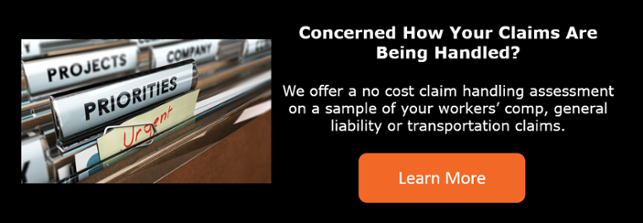
3 Techniques for Successful Medical Canvassing
 Medical canvassing is an important step in the claim handling process. This is done when an adjuster believes the injured employee’s injury occurred outside their scope of employment. The investigation will determine if the employee has had any undisclosed medical treatments before their date of injury.
Medical canvassing is an important step in the claim handling process. This is done when an adjuster believes the injured employee’s injury occurred outside their scope of employment. The investigation will determine if the employee has had any undisclosed medical treatments before their date of injury.
Medical canvassing is being utilized more and more in the claims industry. It’s not cost-effective to do this with every claim, but is worth it if you discover that your employee is getting the same prescription from multiple providers, or has received treatment for an injury prior to the workers' compensation date of accident.
An Injured Knee
John, and employee for a transit company, injured his knee while dropping off a delivery. Due to recent snowfall, the driveway was slippery, causing him to twist his knee and pull a muscle. Every time I spoke to the employee, he provided a slightly different story of how the accident occurred. Slight variations may be okay, but I had a feeling that there may be more to the story for this claim.
We performed a medical canvass whereby 24 hospitals, 15 pharmacies and 10 walk-in clinics were contacted. We found that of the 24 hospitals canvassed, he visited 9 either before or after the accident. There were 4 visits to walk-in clinics prior to the accident for knee pain. Of the 15 pharmacies contacted, he had pain-reliever prescriptions filled at 8 of them, some prior to the accident as well.
After additional interviews with the employer, employee and provider, we determined that the employee’s injury occurred prior to the work-related accident, and therefore denied the claim.
This isn’t always how the investigations end up, but if there are any red signals during the claim handling process, it is worthwhile to investigate.
 #1 Check Pharmacies
#1 Check Pharmacies
Reach out to the employee’s pharmacy to see what medications the employee is taking, and what providers are prescribing them. If you have the patient’s date of birth, the pharmacy will typically provide this information. Is the employee getting similar prescriptions filled at numerous pharmacies?
This is a good starting point to determine what providers the employee is receiving treatment from. Determine if the prescriptions he is receiving are relevant to the type of injury such as pain pills or muscle relaxers. After you have that information you can call the doctor’s office to find out when the employee’s first and last appointment was with that doctor and if they have any further appointments scheduled.
#2 Check Pain Clinics, Hospitals and Urgent Care Facilities
Determine if the employee has visited any medical providers prior to the accident date, and if the injury is similar.
Just because you have knowledge of a certain doctor or facility the employee has received treatment from, don’t stop there! It does not mean this is the only facility they have gone to for the same injury. This is hit or miss with obtaining information from the providers.
#3 Check Provider
Verify that the employee is being treated by a provider. When you contact the provider, they may request a HIPAA authorization form signed by the employee. Once the provider has received the release form, they will be able to offer more insight as to the employee’s treatment.
Conclusion
Medical canvassing is becoming all too familiar in the insurance industry. Insurance fraud is on the rise, and causing insurance premiums to increase. We can no longer just take the claim at face-value. If there are signs of fraud, perform a medical canvass to help determine if the injury occurred outside the scope of work, or if the employee is receiving multiple prescriptions due to drug abuse.


